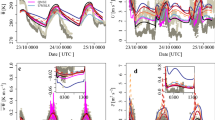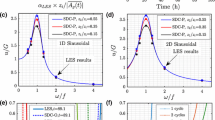Abstract
The steady-state, horizontally homogeneous, neutral, barotropiccase forms the foundation of our theoretical understanding of the planetary boundary layer (PBL).While simple analytical models and first-order closure models simulate atmospheric observationsof this case well, more sophisticated models, in general, do not. In this paperwe examine how well three higher-order closure models, E - ∈ - l, E - l, and LRR - l,which have been especially modified for PBL applications, perform in predicting the behaviour of thecross-isobaric angle α0, the geostrophic drag coefficient Cg, and the integral of the dissipationrate over the boundary layer, as a function of the surface Rossby number Ro. For comparison we alsoexamine the performance of three first-order closure mixing-length models, two proposed byA. K. Blackadar and one by H. H. Lettau, and the performance of the standard model forsecond-order closure and a modification of it designed to reduce the overprediction of turbulence inthe upper part of the boundary layer.
Similar content being viewed by others
References
Andren, A.: 1991, 'A TKE-Dissipation Model for the Atmospheric Boundary-Layer', Boundary-Layer Meteorol. 25, 207–221.
Apsley, D. D. and Castro, I. P.: 1997, 'A Limited-Length Scale K –∈ Model for the Neutral and Stably-Stratified Atmospheric Boundary-Layer', Boundary-Layer Meteorol. 83, 75–98.
Blackadar, A. K.: 1962, 'The Vertical Distribution of Wind and Turbulent Exchange in a Neutral Atmosphere', J. Geophys. Res. 67, 3095–3102.
Blackadar, A. K.: 1965, 'A Single Layer Theory of the Vertical Distribution of Wind in a Baroclinic Neutral Atmospheric Boundary Layer', in Flux of Heat and Momentum in the Planetary Bound NEUTRAL, ary Layer of the Atmosphere, Final Report, AFCRL-65-531, Department of Meteorology, The Pennsylvania State University, University Park, PA, pp. 1–22.
Coleman, G. M.: 1999, 'Similarity Statistics from a Direct Numerical Simulation of the Neutrally Stratified Planetary Boundary Layer', J. Atmos. Sci. 56, 891–900.
Detering, H.W. and Etling, D.: 1985, 'Application of the K –∈ Turbulence Model to the Atmospheric Boundary Layer', Boundary-Layer Meteorol. 33, 113–133.
Duynkerke, P. G.: 1988, 'Application of the K –∈ Turbulence Closure Model to Neutral and Stable Atmospheric Boundary-Layers', J. Atmos. Sci. 45, 865–880.
Etling, D. and Brown, R. A.: 1993, 'Roll Vortices in the Planetary Boundary Layer: A Review', Boundary-Layer Meteorol. 65, 215–248.
Freeman, F. R. and Jacobson, M. Z.: 2002, 'Transport-Dissipation Analytical Solutions of the K –∈ Turbulence Model and their Role in Predictions of the Neutral ABL', Boundary-Layer Meteorol. 102, 117–138.
Garratt, J. R. and Hess, G. D.: 2002, 'The Idealised, Neutrally Stratified Planetary Boundary Layer', in J. R. Holton, J. Pyle, and J. Curry (eds.), Encyclopaedia of Atmospheric Sciences, Academic Press, London, in press.
Hess, G. D. and Garratt, J. R.: 2002, 'Evaluating Models of the Neutral, Barotropic Planetary Boundary Layer Using Integral Measures. Part I. Overview', Boundary-Layer Meteorol. 104, 333–358.
Huang, C. and Raman, S.: 1991, 'Numerical Simulation of January 28 Cold Air Outbreak during GALE. Part I: The Model and Sensitivity Test of Turbulence Closures', Boundary-Layer Meteorol. 55, 381–407.
Jones, W. P. and Launder, B. E.: 1972, 'The Prediction of Laminarization with a Two-EquationModel of Turbulence', Int. J. Heat Fluid Flow 15, 301–314.
Koo, Y. and Reible, D. D.: 1995, 'Flow and TransportModeling in the Sea-Breeze. Part I: Amodified K –∈ Model with a Non-Equilibrium Level 2.5 Closure', Boundary-Layer Meteorol. 75, 109–140.
Kung, E. C.: 1966, 'Large-Scale Balance of Kinetic Energy in the Atmosphere', Mon. Wea. Rev. 94, 627–640.
Launder, B. E.: 1990, 'Phenomenological Modelling: Present...and Future?', in Whither Turbulence? Turbulence at the Cross Road, Proceedings of Workshop Held at Cornell University, Ithaca, NY, March 22-24, 1989, Springer-Verlag, Berlin, New York, pp. 439–486.
Launder, B. E., Reece, G. J., and Rodi, W.: 1975, 'Progress in the Development of a Reynolds-Stress Turbulence Closure', J. Fluid Mech. 68, 537–566.
Lettau, H.: 1962, 'Theoretical Wind Spirals in the Boundary Layer of a Barotropic Atmosphere', Beitr. Phys. Atmos. 35, 195–212.
Moeng, C.-H. and Sullivan, P. P.: 1994, 'A Comparison of Shear-and Buoyancy-Driven Planetary Boundary Layer Flows', J. Atmos. Sci. 51, 999–1022.
Wippermann, F.: 1971, 'A Mixing-Length Hypothesis for the Planetary Boundary Layer Flow in the Atmosphere', Beitr. Phys. Atmos. 44, 215–226.
Xu, D. and Taylor, P. A.: 1997a, 'An E –∈ –l Turbulence Closure Scheme for Planetary Boundary-Layer Models: The Neutrally Stratified Case', Boundary-Layer Meteorol. 84, 247–266.
Xu, D. and Taylor, P.A.: 1997b, 'On Turbulence Closure Constants for Atmospheric Boundary-Layer Modelling: Neutral Stratification', Boundary-Layer Meteorol. 84, 267–287.
Author information
Authors and Affiliations
Rights and permissions
About this article
Cite this article
Hess, G.D., Garratt, J.R. Evaluating Models Of The Neutral, Barotropic Planetary Boundary Layer Using Integral Measures: Part Ii. Modelling Observed Conditions. Boundary-Layer Meteorology 104, 359–369 (2002). https://doi.org/10.1023/A:1016525332683
Issue Date:
DOI: https://doi.org/10.1023/A:1016525332683




